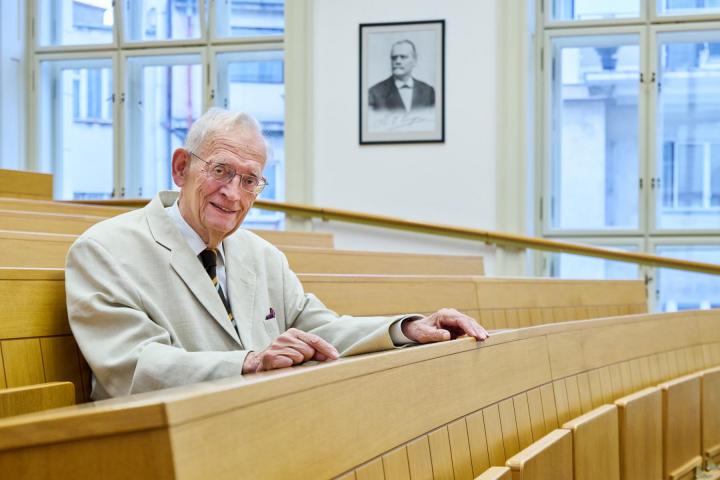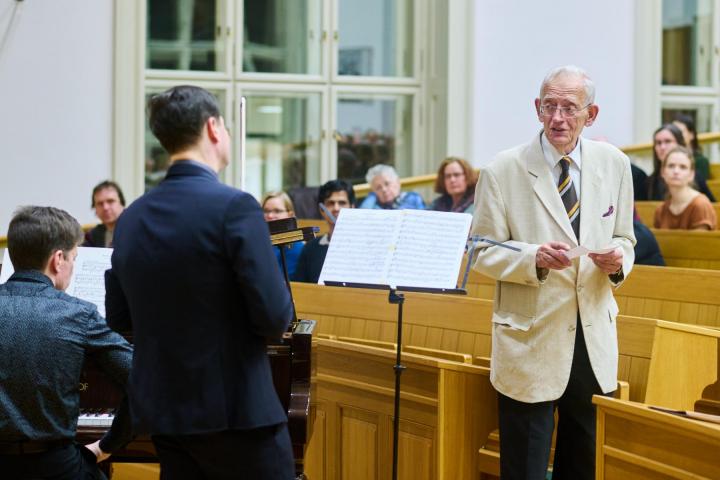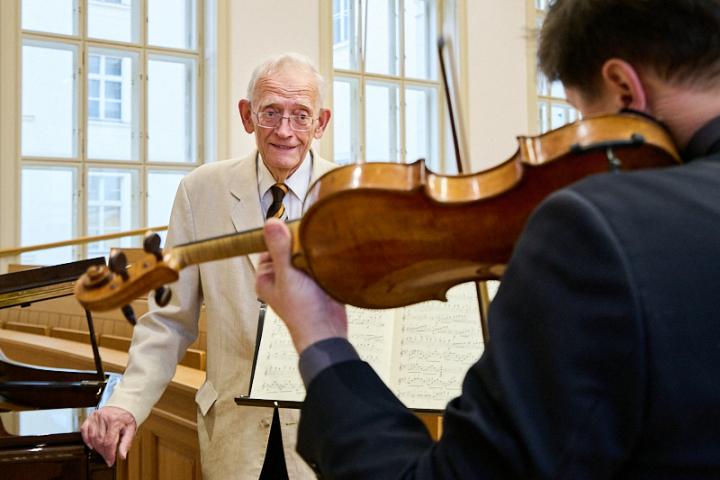
In the 1970s in Czechoslovakia, he and his group developed a receiver for the American GPS satellite navigation system. Information about GPS was classified, so his friends secretly brought him a magazine from the US with a basic description. "It took many months of research and experimentation before we could receive the satellite signals," says Professor Vejražka, who celebrates his birthday on 6th April.

You started to organize Meetings with Music in 2010. The event is not as formal as classical music concerts. It takes place in the Zenger Auditorium. Listeners do not require formal attire. You moderate the show. Why did you choose this atypical format?
At that time, I was organizing orchestral concerts for the whole CTU on the occasion of the New Year, the opening of the academic year, etc. Professor Václav Hlaváč came to me with an idea to prepare a concert for our employees who were coming from work, not dressed festively and would welcome a moment of calming down with excellent music. That's how the current format came about. I prepare and organise the program and moderate the concerts. We chose the Zenger Auditorium because it has excellent acoustics and is free.
During the concert, the audience will also learn a lot of exciting facts thanks to your verbal input between the songs. How do you choose what information you present in your entrances?
I don't want the Meetings with Music to resemble unpopular elementary school concerts. Listeners will find the programme with biographical data on the leaflet they receive on entry. Many are preparing for the Meetings with Music, so they know a lot of biographical information about the authors from the Internet. Therefore, I approach the composer regarding the life situation or the emotions that influenced the composition. I draw from various biographical sources, preferably letters, which are sometimes published. Mozart's letters to his father, for example, are magical. I look up correspondence from when the musician composed the piece and then pick out interesting facts. A detailed written commentary emerges, from which I usually choose what to say on the spot: depending on my mood, the mood of the performers, and the atmosphere in the auditorium. For example, my written preparation for the last Meetings with Music was 22 pages long.
Do you ever get stage fright when moderating concerts?
I don't. It's my upbringing. My father was a teacher, an amateur actor, a great speaker, and an entertainer. He watched and corrected my speeches when I participated in various Olympiads, technical competitions, and music school performances.
At the beginning of my teaching career, we used to have a lot of listeners at the school, so I considered it an honour to give a 90-minute lecture for 200 listeners. Within the Czech Association of Scientific and Technical Societies, I gave lectures in courses for 500 people. I got used to giving speeches.
But it's a different story if you perform in front of an orchestra, which I used to do before the dress rehearsal. I say there that it is a feast for the audience, and I want to make the ensemble members wish to participate. That will come through in the quality of the concert. But it's challenging for me in a way: you're standing in front of a hundred artists ready to deliver the ultimate experience. The hall alone has a unique atmosphere. I experience these moments not with stage fright but with respect for the atmosphere.
You understand the music. Do you play an instrument yourself?
I used to play the violin and the piano. But after an accident, a ruptured tendon in my left hand prevented me from doing so.
What are your plans for the next academic year for Meetings with Music?
The year 2024 will be the Smetana Year, marking 200 years since the birth of Bedřich Smetana. Leoš Janáček and Josef Suk also have anniversaries. We will be performing piano pieces by Smetana performed by Mrs. Jitka Čechová, nice things with the Czech Trio, the Belfiato Quintet, and another important soloist, and I won't reveal the name, just the top again.

Let's get on with your scientific work. Please briefly explain how satellite navigation systems work.
There are four in operation: GPS, Galileo, Glonas and BeiDou. They all work on the same principle. They can measure the time it takes for a signal from a satellite to reach a receiver. This also measures the satellite-to-user distance. And then it's a task similar to the one in primary school - construct a triangle when we know the three sides. The third vertex that is sought is the point at which you are. All systems measure about equally accurately, with position error between five and eight meters. You need to see at least four satellites to measure, but surrounding buildings can hinder this. In addition, received signals shouldn't reach the receiver by reflection, e.g., from surrounding buildings.
You led a team of scientists who evaluated whether these laws cause adverse situations in measuring the location of Prague trams. Can you elaborate on that?
Measuring the location of public transport vehicles allows us to manage traffic, deploy vehicles operatively, display at stops when the relevant service arrives, etc. However, the receiver in the tram measures inaccurately because the buildings around the street create a canyon from which the four satellites mentioned above cannot be seen, as the signals are reflected from the houses. In Prague, this happens for example in Jindřišká, Vodičkova and Lazarská streets.
The Prague Transport Company was considering the deployment of satellite navigation receivers on trams and wanted to know whether there would be problems with accuracy, perhaps due to the surroundings. And we evaluated this using our satellite navigation receiver.
Is there any challenge in the development of satellite navigation systems?
They are still being improved. And it's crucial to have good information, especially when you have, for example, an older GPS receiver that wasn't even expected to be in service now. For example, recently, there was a problem with the so-called roll-over. Older receivers stopped working because the clock on the satellite sends a pulse every 1.5 seconds that is stored in the receiver. When the receiver's memory fills up, the receiver has to handle it. Older receivers couldn't do that and failed. It happened after 20 years of operation. We've helped a number of companies get back up and running.
During the Cold War, scientists started developing satellite navigation systems in the 1970s. Scientists did not share information between East and West. How difficult was the development without knowledge sharing?
Satellite navigation systems belong to the family of radio-based systems whose principles which are known since the 1930s. That was not the problem. We had to obtain information about the parameters of the signals sent by satellites to receive them.
So there was already something to build on.
The methods are different, local, whereas satellite systems are global. Local systems use terrestrial infrastructure, usually radio beacons. Their range is limited to 150 to 300 km. If an aircraft leaves coverage, it has to change to another beacon. Knowing these systems is also helpful if you want to work in satellite navigation.
For us, it was still helpful to learn about the Omega system. Humanity has always wanted a global system. People knew signals at very long wavelengths (around 10 kHz) propagate well over the sea. Thus, under the direction of the United States, eight beacons were built around the globe (Norway, Reunion, Dakota, Argentina, Liberia, Hawaii, Australia, and Japan). The signals received by the user from the Omega beacons were delayed by a time corresponding to the distance between the user and the beacon. The user's position could be determined with an error of about two kilometers, which was acceptable in the 1970s.
I was introduced to Omega at the request of Czechoslovak Airlines (CSA). They needed to calculate the position of an aircraft by knowing the position of two beacons on Earth and measuring how far away the aircraft was from the beacons. This is still the same problem of constructing a triangle if we know the length of the three sides. They wanted to compare the position thus obtained with the data measured by the Omega system and evaluate the error - that was my task.
Why was this necessary?
Planes had to fly on flight paths. These were 120 nautical miles wide over the Atlantic (about 200 km). By 1973, the flight paths were no longer sufficient for the thickening traffic over the sea, so they were narrowed to 60 nautical miles by international agreement. Any airline wishing to use them had to demonstrate that it could stay within them. Otherwise, it would have to fly at lower flight levels, where aircraft consume more fuel, have to refuel more often, and are more expensive to fly. There can be no local system beacons at sea, so radio navigation was impossible. The challenge was the Omega system, but it had to be proven that CSA had it, could use it and could stay on the flight path with it. This required mounting an Omega receiver on the aircraft and conducting test flights at least within range of ground beacons, using them to obtain a position and compare it with the position measured by Omega. This was to be done by means of calculations that I carried out.
How did politics interfere?
Without the manufacturer's consent, you can't build any equipment into an aircraft. We were in the Cold War era. We only had Soviet aircraft, so building an American receiver into a Soviet Ilyushin was a problem. The then chief navigator of the CSA, Ing. Josef Kříha, in Moscow finally managed to push the idea to get the American Bendix navigation receiver installed in planes. My colleagues from CSA flew it to New York and Havana and on routes to Moscow and further east and collected data, brought it back, and I did the math.
Did the testing go well?
Excellent. Initially, the Omega errors in Europe were significant, up to 20 km. This was due to the fact that the essential part of the receiver is a map of the Earth's conductivity. It was incorrect and needed to be fixed. So the company changed the receiver software based on our results, and there was an improvement, this was repeated several times until it reached a good 800 m.
In 1973, the Americans began to develop the GPS navigation system. The information was classified. So what was the development of the navigation system like?
Ironically, our authorities kept the information on GPS secret in our country. Literary sources were stamped with the stamp that the publication was not for public distribution, and the magazine or book was kept in the archives of the Interior Ministry. This also affected the 1975 magazine Navigation, which contained a description of the system. However, friends bought it in the USA and brought the magazine to us. We studied it, and my Ph.D. student built a simple version of the receiver. The software was essential, but we mastered that over time and built a prototype receiver that met aviation standards. Our work was supported mainly by the MESIT company in Uherské Hradiště (Measuring and Signalling Technology, abbreviated MESIT, was a Czechoslovak national enterprise that specialized in the production of aeronautical instrumentation and communication technology since its foundation in 1952 - note), to which we handed over the prototype for production on 1st January 1990. Mesit was the only manufacturer of GPS receivers in the Eastern Bloc. It produced about fifty receivers for the L-610 Warsaw Pact aircraft.
What do you consider your most outstanding career achievement?
I am at the end of my life, and there has been many of achievements. The greatest - although very simple - is that I developed a procedure that made it possible to equip CSA aircraft with Omega system receivers. Thus, Czechoslovakian Airlines became one of the companies that could fly across the Atlantic in restricted flight paths.
Interview conducted by Markéta Rizikyová
Photos by Petr Neugebauer, FEE CTU
**********
Profesor Ing. František Vejražka, CSc.
Born on 6 April 1942 in Pardubice in the family of a physics teacher.
After graduating from the Pardubice Industrial School, he started his studies at the Faculty of Radio Engineering of the Czech Technical University, located in the castle in Poděbrady. From his first year, he was an auxiliary scientific force in the laboratory of radio measurements.
From 1969 he worked as an assistant professor at the Department of Radio Electronics. He graduated as a postdoctoral researcher, became an associate professor in 1982, and a professor in 1996.
In the 1970s, due to heavy traffic, flight paths over the Atlantic were narrowed. However, only aircraft that could fly at the more economical higher levels could stay within the narrowed corridors. Professor Vejražka's method proved that aircraft could remain on the routes using the Omega navigation system.
Thanks to his friendship with the CSA staff, Professor Vejražka was given an American magazine with detailed descriptions of the newly developed GPS navigation system. His bet on the development of satellite navigation methods made him famous worldwide.
After the revolution, he became the contact person for the Civil GPS System Information Committee of the US Department of Defense and the Department of Transportation.
He has been a Fellow of the Royal Institute of Navigation in London since 2002.
In 2001, he was awarded the Ministry of Education, Youth, and Sports Medal for his teaching activities. He is the author and co-author of several scripts published by CTU. He has published in renowned scientific journals.
From 1999 to 2001, he was Vice-Dean for Science and Research at the CTU Faculty of Science. Between 2001 and 2011, he served as Vice-Rector for Marketing and PR. During this time, he was responsible for renovating the Bethlehem Chapel, organizing large university concerts, establishing the university orchestra, and organizing visits of the Prime Minister and the President of the Czech Republic to CTU. He also co-founded the Faculty of Biomedical Engineering at CTU.
He has had a relationship with classical music since childhood. His father was a member of the amateur association at the Pardubice Theatre. Professor Vejražka, for example, still knows the part of Floridor from the operetta Mamzelle Nitouche, sung by Oldřich Nový and sung by Vejražka's dad.
In 2010, he and Professor Václav Hlaváč co-founded the tradition of Meetings with Music evenings, which opened the world of classical music to members and friends of the CTU academic community.